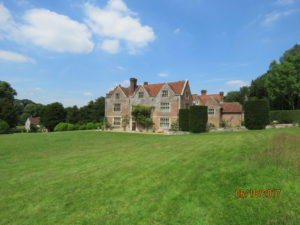 Chawton House is an Elizabethan manor in the village of Chawton in Hampshire, England. Formerly the property of Jane Austen’s brother, Edward Austen Knight, it is now is managed by the National Trust and open for tours. I couldn’t hardly wait to visit this historic site during my research tour in England.
Chawton House is an Elizabethan manor in the village of Chawton in Hampshire, England. Formerly the property of Jane Austen’s brother, Edward Austen Knight, it is now is managed by the National Trust and open for tours. I couldn’t hardly wait to visit this historic site during my research tour in England.
The current Chawton house was built by the Knight family in the 1580s on the site of a medieval manor house dating back to the 1200s.
The Knights were not quite in the class of gentlemen, but rather yeomen, which is a step below, but still considered respectable, ranking higher than the working class since they owned property with tenants. During the Elizabethan era, the Knight family embarked on the construction project for much of the present-day Chawton House.
The 17th-century house was constructed of flint with a tile roof and stone dressings. The three gabled-south side has two storeys and an attic. It also possesses a famous library with an impressive number of books which were an expensive commodity in those days. Today many of those volumes are priceless. What makes this library so unique is the number of tomes written by women poets and novelists, and those written by men who were what people today would consider feminist they way they glorify women warriors. I wonder if they inspired Jane Austen in some small way.
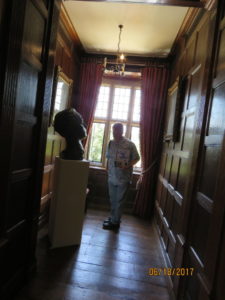
Today’s entrance hall was once the great hall. Screens to help cut down on drafts originally stood along the great hall near the door, but later descendants walled off a walkway or passageway to keep the great hall warmer.

When I first walked in, I noticed buckets along the ceiling. Apparently, they were stored there in the event of a fire; the residents could quickly form a bucket brigade.
In later years, the Knight family was plagued by a lack of sons, and so many males who were not direct descendants inherited the house and property over the generations, each changing their birth surname to Knight to assume ownership of the property. The Knight family adopted Edward Austen, one of Jane Austen’s older brothers. Adoption was a very rare event in those days, and I have not yet discovered exactly why they chose Edward as their adopted son. The Knights were relatives who had no children and the Austens had 5 boys.
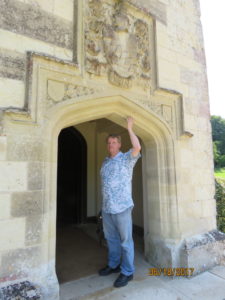
Jane Austen stayed in Chawton house on and off during her life. After Edward inherited the estate, he allowed his widowed birth mother and unmarried sisters, Jane and Cassandra, to live in a cottage nearby. It is here where Jane seemed most happy and enjoyed the most success as an author.
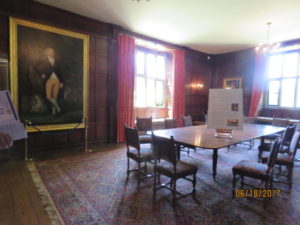
Chawton House was considered one of the big houses in the area. However, I was struck by its humble nature compared to other stately homes I toured during my visit to England. The rooms are small, dark, and cramped, with very low doorways. The floors on the upper levels slope dramatically. Still, compared to the cottage where Jane lived the last several years of her life, as well as the tiny and primitive tenant homes that must have been on the estate, it probably seemed grand, indeed. The house is full of quaint and charming rooms, many of which are furnished with the same furniture Jane and her brother used. I couldn’t help but reverently run my hand over the very table where Jane dined during her visits.
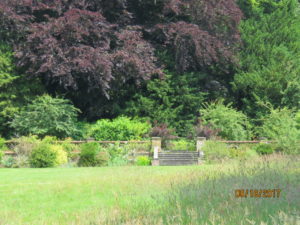 Today’s estate on which Chawton house resides is approximate 275 acres. The grounds and gardens are lovely! I could have spent hours exploring them despite the record heatwave England suffered during part of my visit. The grounds offer a combination of a wilderness through which paths meander, and more formal gardens. Natural lawns spread out in all directions where animals graze,
Today’s estate on which Chawton house resides is approximate 275 acres. The grounds and gardens are lovely! I could have spent hours exploring them despite the record heatwave England suffered during part of my visit. The grounds offer a combination of a wilderness through which paths meander, and more formal gardens. Natural lawns spread out in all directions where animals graze,  contained by discrete ditches cut into the hillside known as ha-has which are virtually unseen from the house. The grounds also have terraces, stone stairways, a profusion of flowers and flowering shrubs, fruit trees and shade trees, and comfortable places to sit and enjoy the great outdoors.
contained by discrete ditches cut into the hillside known as ha-has which are virtually unseen from the house. The grounds also have terraces, stone stairways, a profusion of flowers and flowering shrubs, fruit trees and shade trees, and comfortable places to sit and enjoy the great outdoors.
 Edward’s house and garden made an impression on Jane Austen and seem to have influenced her novels, especially Emma. Some scholars believe Mr. Knightly’s Donwell Abbey was based upon the Knight family’s Chawton House. Perhaps this is why Jane chose the surname of Knightly for her fictional hero, who, by the way is one of my favorite Austen heroes.
Edward’s house and garden made an impression on Jane Austen and seem to have influenced her novels, especially Emma. Some scholars believe Mr. Knightly’s Donwell Abbey was based upon the Knight family’s Chawton House. Perhaps this is why Jane chose the surname of Knightly for her fictional hero, who, by the way is one of my favorite Austen heroes.

My friend and fellow Regency Author, Julie Roberts, and her husband Tony, were so kind to offer us their hospitality during this portion of our trip to England, and to bring us to this historic location. I will always appreciate their generosity.
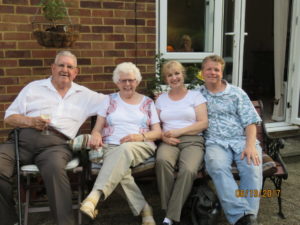
Sources:
My visit in June of 2017, the Chawton House Guide, and Wikipedia.

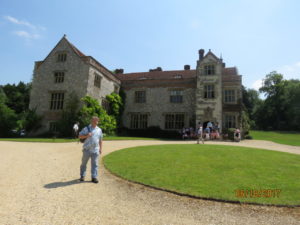
One day I’ll visit Chawton!
Have you read “Jane and I: My Austen heritage” ?
I just got it and I think you’ll love it.